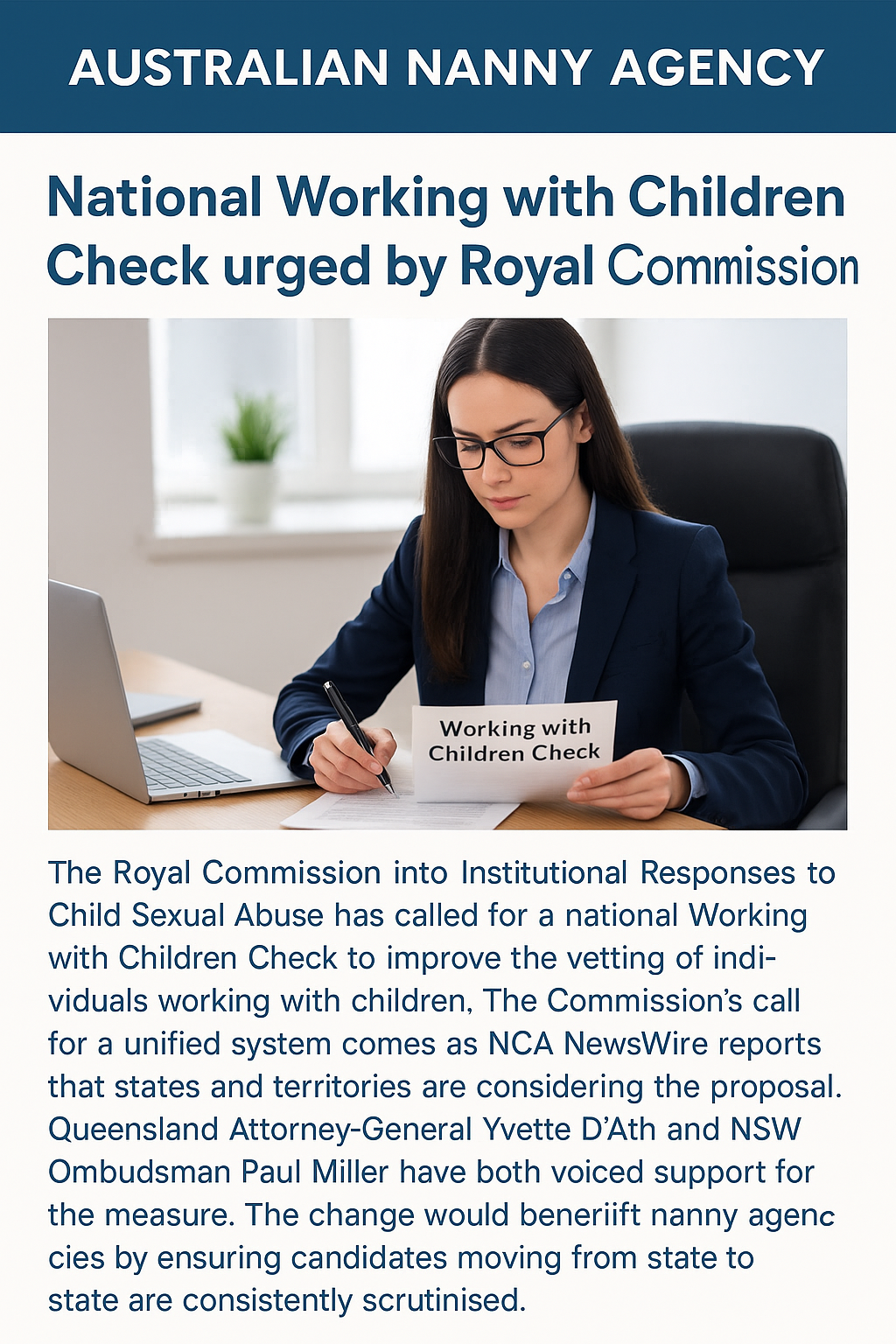Push for National Working with Children Check

Share
Why a National Working With Children Check
Matters for Families and Nanny Agencies
Amid mounting pressure from industry experts, child safety advocates, and the broader community, there are renewed calls for Australia to implement a national Working With Children Check (WWCC) system. As a leading nanny agency placing vetted professionals across multiple states and territories, we strongly support these efforts — not only for consistency, but for the safety and confidence of families nationwide.
“It’s Not Rocket Science”: The Case for a National System"
Radio broadcaster Ray Hadley reignited public debate this week, stating bluntly: “It’s not rocket science. We need one Working With Children Check, not eight separate systems.” His comments follow growing frustration that, despite repeated recommendations, there remains no centralised database for vetting childcare professionals across Australia.
Hadley’s remarks echo one of the core findings of the Royal Commission into Institutional Responses to Child Sexual Abuse, which recommended the creation of a nationally consistent approach to child safety screening. Yet nearly a decade later, childcare workers — including private nannies — still must apply separately in each state they work in, with no unified system tracking misconduct or barring orders across borders.
Why This Matters for Parents Hiring Nannies
As a nanny agency working with families in NSW, VIC, QLD, WA and beyond, we regularly onboard candidates who’ve worked in multiple states. This exposes a significant risk:
"A nanny may hold a valid WWCC in one state while having a suspended or flagged record in another — and there is no automatic alert system between jurisdictions. " Justine Murray Australian nanny Agency
This lack of coordination means families hiring directly (without an agency) might unknowingly employ someone who wouldn’t pass a check elsewhere.
The Federal Government’s Response
In light of recent childcare scandals, including the high-profile Joshua Brown case involving over 70 charges of child sexual abuse, federal regulators are under growing pressure to act. As reported in The Daily Telegraph, Prime Minister Anthony Albanese has signalled support for stronger national oversight but has yet to commit to a unified WWCC model.
Meanwhile, states like Victoria are pushing ahead with individual childcare workforce registers, but critics say this piecemeal approach is too slow and continues to leave loopholes.
What We Do at the Australian Nanny Agency
At our agency, we believe vigilance shouldn’t depend on postcode.
That’s why we:
- Require WWCC or Blue Card checks for every placement, regardless of state
- Cross-check candidates who have lived or worked interstate
- Require full disclosure of any prior working bans or suspensions
- Are lobbying for a unified register to protect both families and children
We believe the burden of protection shouldn’t fall solely on parents — and that regulation must catch up to how modern families and professionals actually live and work.
What Families Can Do Now
Until a national WWCC exists, families should:
- Ask whether your nanny or agency has checked across multiple states
- Request a copy of the current WWCC card or verification
- Partner with agencies who have rigorous compliance checks
- Avoid hiring independently unless you can confidently verify documents and references
Conclusion: Safety Demands Unity
Child protection shouldn’t depend on state borders. In a country as mobile as Australia, where nannies often move for work, fragmented screening is a loophole we can’t afford. The time for a national Working With Children Check isn’t next year or next term — it’s now.
For trusted, fully vetted nannies across Australia, contact the Australian Nanny Agency today.
Your children deserve nothing less.
FAQs about working with children checks
What is a Working With Children Check (WWCC)?
A background screening used to determine if a person is suitable to work with children, including criminal and misconduct history.
Why isn’t there just one national WWCC?
Each state runs its own system. A national check has been recommended but hasn’t been adopted yet.
Can a nanny be cleared in one state but banned in another?
Yes. Without a national system, someone could pass in one state while flagged in another.
What has the Royal Commission said about this?
It strongly recommended a unified, national WWCC to close safety loopholes across Australia.
How does this affect families hiring nannies?
You could unknowingly hire someone who’s banned in another state if checks aren’t cross-referenced.
What does your agency do differently?
Each state has an online verification tool. We provide full details before placement.
What’s the risk of hiring without an agency?
If you hire directly, you might miss red flags — agencies have processes to catch them.










